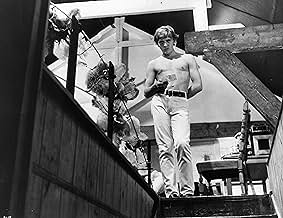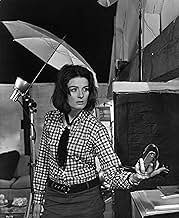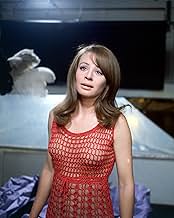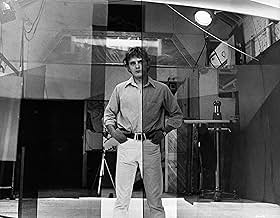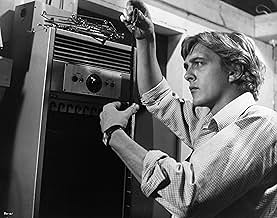Nella Londra dell'era Mod, un fotografo nota un'immagine sospetta nelle foto che ha scattato di una donna misteriosa in un parco desolato.Nella Londra dell'era Mod, un fotografo nota un'immagine sospetta nelle foto che ha scattato di una donna misteriosa in un parco desolato.Nella Londra dell'era Mod, un fotografo nota un'immagine sospetta nelle foto che ha scattato di una donna misteriosa in un parco desolato.
- Regia
- Sceneggiatura
- Star
- Candidato a 2 Oscar
- 8 vittorie e 9 candidature totali
Veruschka von Lehndorff
- Verushka
- (as Verushka)
Jeff Beck
- Self - The Yardbirds
- (non citato nei titoli originali)
Roy Beck
- Boy dancing In Ricki Tick Club
- (non citato nei titoli originali)
Charlie Bird
- Homeless Man
- (non citato nei titoli originali)
Susan Brodrick
- Antique shop owner
- (non citato nei titoli originali)
Robin Burns
- Homeless Man
- (non citato nei titoli originali)
Tsai Chin
- Thomas's receptionist
- (non citato nei titoli originali)
Julio Cortázar
- Homeless Man
- (non citato nei titoli originali)
Chris Dreja
- Self - The Yardbirds
- (non citato nei titoli originali)
Recensioni in evidenza
BLOW-UP is NOT "about the possible dehumanizing effects of photography..." but rather a movie version of the philosophical question: "If a tree falls in the forest and no one hears it, does it make a sound?"
In this case, if a murder is committed and there is no evidence, did it really happen?
While seemingly about a successful, but hedonistically superficial, photographer who films both wartime brutalities and fashion, Thomas (David Hemmings) comes to finally realize that his images only create an illusion of the real world.
He discovers that he has accidentally photographed a murder when he develops and enlarges ("blows up") the images of photographs taken of a couple in an otherwise deserted park. He even returns to the scene and finds the victim's body. But when the photographs AND the negatives AND the body disappears AND there is no report of a missing person, he discovers that he has no evidence of a murder having occurred.
In the end, when he throws back the imaginary tennis ball to the pantomime players on the tennis court, he realizes that what he accepts as reality is really only an illusion.
In this case, if a murder is committed and there is no evidence, did it really happen?
While seemingly about a successful, but hedonistically superficial, photographer who films both wartime brutalities and fashion, Thomas (David Hemmings) comes to finally realize that his images only create an illusion of the real world.
He discovers that he has accidentally photographed a murder when he develops and enlarges ("blows up") the images of photographs taken of a couple in an otherwise deserted park. He even returns to the scene and finds the victim's body. But when the photographs AND the negatives AND the body disappears AND there is no report of a missing person, he discovers that he has no evidence of a murder having occurred.
In the end, when he throws back the imaginary tennis ball to the pantomime players on the tennis court, he realizes that what he accepts as reality is really only an illusion.
I would recommend that people who are considering watching this film for the first time not read the following. I don't mention the film's ending, I just believe its far more satisfying to let the films potent details nervously sink into place on their own.
It is not about cameras. It is not about seeing. It is about our perception of our individual world. It throws shadows on the very judgments we build our lives upon. Without mentioning the obvious references to illusion (the mimes, the abstract picture of the corpse, etc.), I offer the following expert signposts Antonioni leaves for us to find.
1) The guitar neck David snatches at the rave-up has value only until he is not being chased for it, whereupon he discards it in the street. The pedestrian who then picks it up sees it only as junk.
2) Dialogue with his model friend at the pot party: DAVID - ` I thought you were in Paris.' THE GIRL - `I am'.
3) Appearances and Disappearance (2 of the many). The Lynn Redgrave character pops up as he arrives at his apartment. His question `How did you find me' is not explained. Later in the story, it is notably odd when David wakes up the following morning after the pot party that there is no one to be seen in the party house. Even the decorations like the clothes hung on the statue the night before have vanished.
4) David teaches the affectations of smoking to the woman. She must create an impression.
5) His painter friend describes his painting. `They don't mean anything to me while I work on them. Its only later that I ascribed something to them. Like this leg.' Whereupon he points out a place in a painting that might be a human leg. When he paints, he is tapping subconscious language, something apart from subjective and objective reality. Its as if Antonioni is offering us an even further vantage point to the events to come, dream reality.
6) The rambling diversion of events shows David's inability to `focus' on working through his mystery.
7) So much is hidden from the viewer. Its almost suggested that the real end to the narrative takes place someplace after the movie has already finished, jarring our sense of story, insinuating an ending we never get to `see'.
8) David announces at one point to his friend, `If only I had more money I'd be all right.'. Meanwhile he drives through the whole movie in his Rolls Royce.
This is a very remarkable film. I was irked by the pacing and the diversions as I watched it, but that was exactly why it all kept coming and coming at me for hours after until finally in bed it all rushed through me like a gorgeous musical event. I know for certain there are many more hidden corners to it, but this is what I got in my first viewing. Just that gut feeling that I missed something, I believe, is exactly where Antonioni was going. You always miss something.
It is not about cameras. It is not about seeing. It is about our perception of our individual world. It throws shadows on the very judgments we build our lives upon. Without mentioning the obvious references to illusion (the mimes, the abstract picture of the corpse, etc.), I offer the following expert signposts Antonioni leaves for us to find.
1) The guitar neck David snatches at the rave-up has value only until he is not being chased for it, whereupon he discards it in the street. The pedestrian who then picks it up sees it only as junk.
2) Dialogue with his model friend at the pot party: DAVID - ` I thought you were in Paris.' THE GIRL - `I am'.
3) Appearances and Disappearance (2 of the many). The Lynn Redgrave character pops up as he arrives at his apartment. His question `How did you find me' is not explained. Later in the story, it is notably odd when David wakes up the following morning after the pot party that there is no one to be seen in the party house. Even the decorations like the clothes hung on the statue the night before have vanished.
4) David teaches the affectations of smoking to the woman. She must create an impression.
5) His painter friend describes his painting. `They don't mean anything to me while I work on them. Its only later that I ascribed something to them. Like this leg.' Whereupon he points out a place in a painting that might be a human leg. When he paints, he is tapping subconscious language, something apart from subjective and objective reality. Its as if Antonioni is offering us an even further vantage point to the events to come, dream reality.
6) The rambling diversion of events shows David's inability to `focus' on working through his mystery.
7) So much is hidden from the viewer. Its almost suggested that the real end to the narrative takes place someplace after the movie has already finished, jarring our sense of story, insinuating an ending we never get to `see'.
8) David announces at one point to his friend, `If only I had more money I'd be all right.'. Meanwhile he drives through the whole movie in his Rolls Royce.
This is a very remarkable film. I was irked by the pacing and the diversions as I watched it, but that was exactly why it all kept coming and coming at me for hours after until finally in bed it all rushed through me like a gorgeous musical event. I know for certain there are many more hidden corners to it, but this is what I got in my first viewing. Just that gut feeling that I missed something, I believe, is exactly where Antonioni was going. You always miss something.
Antonioni was not a director that worried too much about people completely understanding his films. In fact I'd bet that he actually hoped they didn't understand everything. So I did not find it strange or surprising when after finishing the movie I felt quite confused. But the movie made me think for a very long time, which in my opinion is what a good film should do. There are so many aspects to this film that if you give them a chance and think about them, they will keep you reeling for hours on possible interpretations. The first and probably most important aspect of this film dealt with love. From what I have seen of his films, love is Antonioni's favorite subject. But this love was different than that of past films; it is much more shallow and un-centered. Thomas, the photographer, is surrounded by women, he goes from one to the next without thinking twice, treating them like dogs the entire time. But he can do this and get away with it because he is a famous photographer and can make the women what they all desperately want to be, Beautiful. For The first half of the movie I honestly did not like his character whatsoever. Whereas in the past the director has chosen mainly to explore the ups and downs of married life, or the problems of being hopelessly devoted to one person, he now points the camera at the single, care free, over sexed, youth of the sixties. Half an hour into the movie I found myself wondering what the heart of the film was going to be. We were introduced to Thomas and his world, but there seemed to be no conflict driving the story forward. Then came the quasi-murder mystery. This is what is really interesting and unique about this film in my opinion. Antonioni for a while leads us to believe that the movie is going to turn into some suspense thriller, or murder mystery, but never seems to quite get there. He has all the elements ready to go, but never follows through with them. He introduces this alluring and mysterious woman who is in on the murder and then never brings her back. The murder victim is discovered, but his identity is never revealed, nor a motive given for his murder. Thomas, after a very energetic and exciting photo investigation seems to not really care too much as to what happens with the investigations results, only telling a couple of his friends who couldn't care less. Antonioni seems to have used this whole murder mystery convention as some sort of glue to hold the rest of the real story together. The story of a mindless, beauty obsessed, celebrity idolizing, drug addicted, and violence obsessed culture. Probably my favorite scene in the film is after fighting over the piece of broken guitar with the other fans; Thomas just discards his prize as garbage. Something that kept bugging me was the antique shop. I kept wondering what in the world it had to do with anything in the movie; it stuck out like a sore thumb. But I knew it that there was some major purpose or explanation for its existence in the film, and then it just kind of clicked. Upon his first entry into the Antique store Thomas encounters an angry old man who we eventually find out is not the stores real owner, the true owner is a beautiful young woman who is planning to sell the old place and travel the world in search of something new. All this stuff she owns, the gold of past cultures, is old and useless now. She has a hard time making a living because nobody wants the stuff any longer. Here is where I think Antonioni's major message is hidden: That is the way life is, it moves on constantly, things change, people die, cultures evolve and the only thing that remains in the end is nature itself. Antonioni finishes the film beautifully, Thomas stands alone in a large field of grass, the only thing heard is the wind and the trees, as the camera backs away slowly, he disappears leaving nothing but the grass blowing in the wind, for like all the antiques and all the people that created them in the past, eventually Thomas's life will end and so will the current popular culture in which he takes part. Change is life's only constant.
If you believe that the ending makes the movie, Blowup is for you. The first 30 minutes seem aimless and wandering, but they set up the main character and what is he is to discover about himself, about his occupation and about art in general. Antonioni builds tension (or frustration as you're watching it) not with plot, but with anti-plot. You want to scream at David Hemmings's character to: focus! screw those models! do something! But as the film unfolds you will see why Antonioni chose this actor, this profession and those girls. A wonderful manifesto about the dangers of voyeurism and what it does to a man's sexuality that is 40 years ahead of its time. The symbolism might get heavy handed at times (mimes, a broken guitar), but the sets are so full of creativity and the actors so beautiful (this will give my age away, but Vanessa Redgrave, who knew?) that you forgive Antonioni (he's Italian after all). Hemmings is Hugh Grant before Hugh Grant, but in this role at least, much more interesting. He's highly sexual, but unlike his painter roommate, his chosen art form represses him, all in the name of the shot. And when he finally gets the perfect shot in the perfect light, it's so perfect that someone steals it, and for good reason. Did those events actually take place or just through his camera lens? When the photos are the proof of what you see, then when that proof is taken away, did you see?
'Blowup' is frequently mentioned as one of the most influential movies of the twentieth century. And I believe it is. But it is no dry and dull document that the viewer must force himself to "appreciate" while he stifles his yawns. Like 'Citizen Kane', 'Breathless' and 'Psycho' it is not only an important movie milestone, it is still a living and breathing work of art that will fascinate and impress any movie lover who approaches it with an open mind. 'Blowup' lures you in with its snapshot of swinging 60s London, and it's tease of being a murder mystery, which it really isn't, but by then you're hooked. This movie is a puzzle with no solution, a text with any interpretation the viewer cares to bring to it. That may sound heavy going and off putting, but this is a surprisingly watchable movie. Even the "boring" sequences are interesting! Anyone who enjoys David Lynch, Dario Argento (whose 'Profundo Rosso' deliberately referenced this), Nic Roeg or Jim Jarmusch, movies where atmosphere and visual images are more important than characterization, plot or dialogue, will appreciate this 60s classic. I think it gets better with every viewing.
Lo sapevi?
- QuizThe film contains a rare performance of The Yardbirds during the period when Jimmy Page and Jeff Beck were both in the band. Jeff Beck would leave a few months later.
- BlooperWhen Thomas is frolicking with the two girls on the purple paper backdrop in the studio, two crew members, including a camera operator, can be seen just sitting there in the top right side of the frame.
- Versioni alternativeSome of the music was rescored for the Warner DVD release, namely the latter part of the opening title music. The VHS releases' music remain intact.
- ConnessioniFeatured in Film Review: How I Learned to Live with Being a Star (1967)
- Colonne sonoreMain Title (Blow-Up)
Written and Performed by Herbie Hancock
I più visti
Accedi per valutare e creare un elenco di titoli salvati per ottenere consigli personalizzati
- How long is Blow-Up?Powered by Alexa
Dettagli
- Data di uscita
- Paesi di origine
- Sito ufficiale
- Lingua
- Celebre anche come
- Deseo de una mañana de verano
- Luoghi delle riprese
- Maryon Park, Woolwich Road, Charlton, Londra, Inghilterra, Regno Unito(scenes where Thomas first photographs Jane and where mime artists play tennis at the end)
- Aziende produttrici
- Vedi altri crediti dell’azienda su IMDbPro
Botteghino
- Budget
- 1.800.000 USD (previsto)
- Lordo in tutto il mondo
- 38.575 USD
- Tempo di esecuzione
- 1h 51min(111 min)
- Mix di suoni
- Proporzioni
- 1.85 : 1
Contribuisci a questa pagina
Suggerisci una modifica o aggiungi i contenuti mancanti



